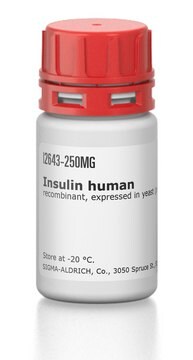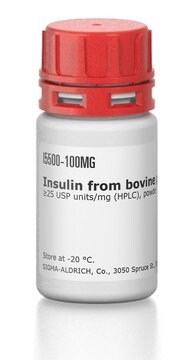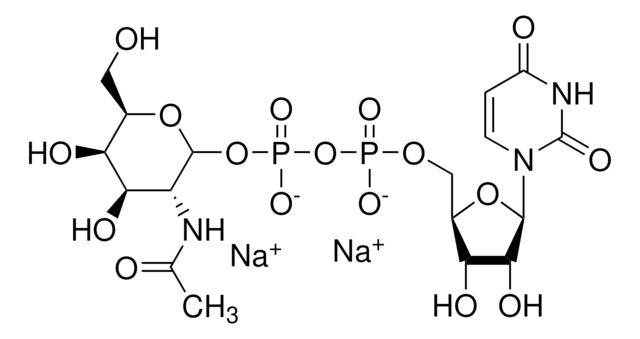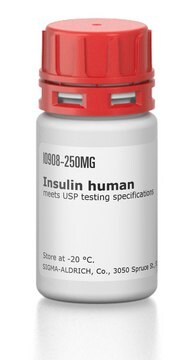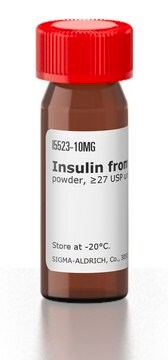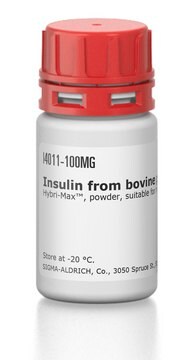I1507
Insulin human
≥95% (HPLC), semisynthetic, powder, non-sterile
About This Item
Recommended Products
biological source
semisynthetic
Quality Level
sterility
non-sterile
Assay
≥95% (HPLC)
form
powder
concentration
>75%
technique(s)
cell culture | mammalian: suitable
solubility
0.01 M HCl: 0.5 mg/mL, clear to slightly hazy, colorless
UniProt accession no.
shipped in
ambient
storage temp.
−20°C
SMILES string
CC[C@H](C)[C@H]1C(=O)N[C@H]2CSSC[C@@H](C(=O)N[C@@H](CSSC[C@@H](C(=O)NCC(=O)N[C@H](C(=O)N[C@H](C(=O)N[C@H](C(=O)N[C@H](C(=O)N[C@H](C(=O)N[C@H](C(=O)N[C@H](C(=O)N[C@H](C(=O)N[C@H](C(=O)N[C@H](C(=O)N[C@@H](CSSC[C@H](NC(=O)[C@@H](NC(=O)[C@@H](NC(=O)[C@@H](NC(=O)[C@@H](NC(=O)[C@@H](NC(=O)[C@@H](NC(=O)[C@@H](NC(=O)[C@@H](NC2=O)CO)CC(C)C)CC3=CC=C(C=C3)O)CCC(=O)N)CC(C)C)CCC(=O)O)CC(=O)N)CC4=CC=C(C=C4)O)C(=O)N[C@@H](CC(=O)N)C(=O)O)C(=O)NCC(=O)N[C@@H](CCC(=O)O)C(=O)N[C@@H](CCCNC(=N)N)C(=O)NCC(=O)N[C@@H](CC5=CC=CC=C5)C(=O)N[C@@H](CC6=CC=CC=C6)C(=O)N[C@@H](CC7=CC=C(C=C7)O)C(=O)N[C@@H]([C@@H](C)O)C(=O)N8CCC[C@H]8C(=O)N[C@@H](CCCCN)C(=O)N[C@@H]([C@@H](C)O)C(=O)O)C(C)C)CC(C)C)CC9=CC=C(C=C9)O)CC(C)C)C)CCC(=O)O)C(C)C)CC(C)C)CC2=CNC=N2)CO)NC(=O)[C@H](CC(C)C)NC(=O)[C@H](CC2=CNC=N2)NC(=O)[C@H](CCC(=O)N)NC(=O)[C@H](CC(=O)N)NC(=O)[C@H](C(C)C)NC(=O)[C@H](CC2=CC=CC=C2)N)C(=O)N[C@H](C(=O)N[C@H](C(=O)N1)CO)[C@@H](C)O)NC(=O)[C@H](CCC(=O)N)NC(=O)[C@H](CCC(=O)O)NC(=O)[C@H](C(C)C)NC(=O)[C@H]([C@@H](C)CC)NC(=O)CN
InChI key
PBGKTOXHQIOBKM-FHFVDXKLSA-N
Gene Information
human ... INS(3630)
Looking for similar products? Visit Product Comparison Guide
General description
Insulin binds to the receptors of target cells in the liver, skeletal muscle and fat, b cells, brain cells, and many other cells. The insulin gene is located on human chromosome 11p15.5.
Application
- in artificial cerebrospinal fluid (aCSF) to study the effect of preoptic area administration of insulin on core body temperature (CBT) in mice
- in contact-mode scanning probe electrospray ionization (SPESI) to study the effect of substrate vibration on ionization efficiency
- as a component of adipocyte differentiation media
Biochem/physiol Actions
Insulin signaling is associated with two important pathways namely: phosphatidylinositol 3-kinase (PI3K, a lipid kinase)/AKT (also known as PKB or protein kinase B) pathway and the Raf/Ras/MEK/ MAPK (mitogen-activated protein kinase, also known as ERK or extracellular signal-regulated kinase) pathway. Insulin increases the metabolic pathways controlling glycogen synthesis, gene expression, DNA synthesis, and Na+/K+ pump. It inhibits metabolic pathways regulating apoptosis and autophagy.
Other Notes
Preparation Note
antibody
related product
Storage Class Code
11 - Combustible Solids
WGK
nwg
Flash Point(F)
Not applicable
Flash Point(C)
Not applicable
Personal Protective Equipment
Choose from one of the most recent versions:
Already Own This Product?
Find documentation for the products that you have recently purchased in the Document Library.
Customers Also Viewed
Articles
Glucose metabolism is regulated by the opposing actions of insulin and glucagon. Insulin is released from pancreatic ß cells in response to high blood glucose levels and regulates glucose metabolism through its actions on muscle, liver, and adipose tissue.
Protocols
Insulin is an approximately 6000 Da peptide hormone used to regulate the glucose concentration in blood. There are several different forms of insulin that are both natural and recombinant; the recombinant forms have been engineered to improve pharmacokinetic properties. A quick and reliable chromatographic technique was developed to identify and detect a mixture of insulin variants in an unknown sample.
Our team of scientists has experience in all areas of research including Life Science, Material Science, Chemical Synthesis, Chromatography, Analytical and many others.
Contact Technical Service